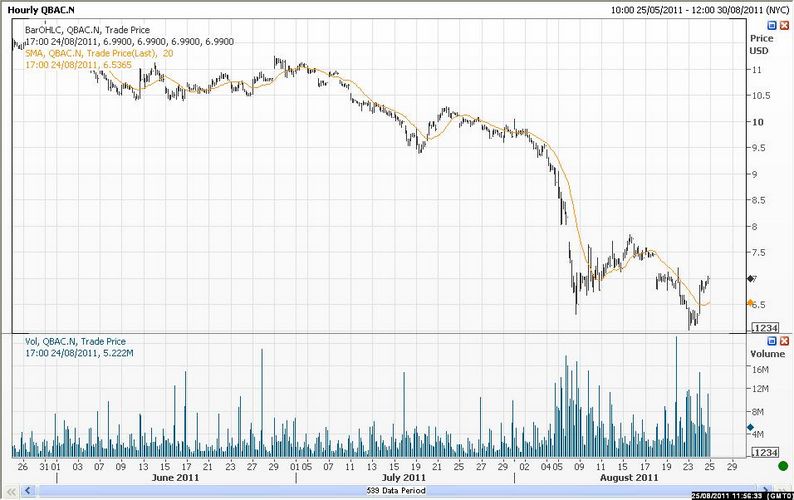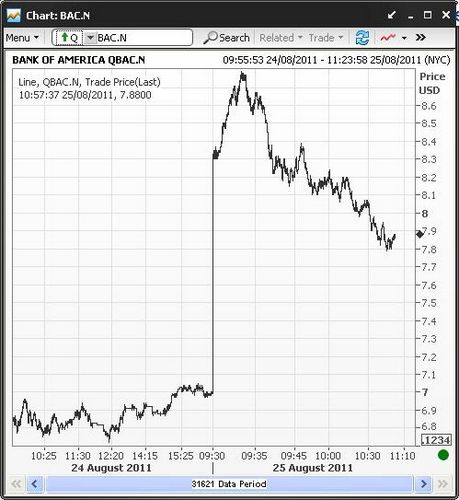
IFR Editor-at-large Keith Mullin
Scenario A: Bank of America is technically insolvent given massive delinquent exposures and significant anomalies in its asset valuations. It is forced into a sizeable equity offering and offloads Merrill Lynch along with a swathe of other assets at fire-sale prices to raise capital to meet regulatory capital requirements.
Scenario B: Bank of America merges with JP Morgan.
Scenario C: Warren Buffett invests $5bn in Bank of America via cumulative perpetual prefs with a chunky 6% dividend, causing shares to rise by 20% in pre-market trading. But that’s a crazy idea, right?
Well, until today only the first two scenarios were the subject of discussion and heated debate. But today we get news that Scenario C is actually true. What a fascinating turn of events. Prior to the Buffet announcement, the BofA talk was all negative. I was taken by how the combination of gossip, nervousness, fatigue, and uncertainty was able to wreak havoc. But the latest news caps a fun-packed few days, weeks and months it’s been for Bank of America.
Prior to the massive spike upwards in BofA stock in pre-market trading Thursday, the stock had closed up almost 11% on Wednesday (August 24) on pretty hefty volume. The bad news is that even with that heady rise, the shares were still languishing below US$7 and even with the Buffet injection, the stock was at US$8.28 by 15.00 London time. The media, social media, the analyst community and the blogosphere in particular have been full this week of tales from BofA.


The constant focus of attention over the past few weeks has been BofA’s asset quality and valuation; potential future write-offs; worryingly high credit default swap levels (five-year touching a record 435bp at one point) not to mention a briefly inverted CDS curve; the fate of the US$8.5bn Countrywide MBS settlement; and talk of those shares succumbing to a death-spiral if management doesn’t act quickly to stabilise the bank..
I don’t get the impression that anyone really thinks Bank of America could go bust – it remains highly liquid for a start – but it’s an issue that’s certainly on people’s minds, as is a potential second government bail-out. Gossip that the bank was in merger negotiations with JP Morgan did the rounds but was swiftly discounted as being fanciful, even though noone said it was an out-and-out stupid idea.
That said, given the huge overlap between the two institutions, I don’t think it makes a lot of sense. Such talk had all the hallmarks of late-summer fabrication concocted to raise the temperature. It’s interesting to note, however, à propos of nothing in particular, that BofA’s market cap of just shy of US$71bn is almost exactly half than that of JP Morgan.
BofA’s share price performance has been so ugly, and its market cap so grievously reduced, that it’s no surprise it’s garnered so much attention. At the US$6.99 close last night, the stock is down 48% year-to-date; yesterday’s close had come off the low for the year of US$6.30 on the previous day (August 23), a level the shares hadn’t seen for two and a half years.
On a five-year view, it’s down more than 85%. There’s still some ways to go before the stock nears the all-time low of those dark post-Lehman days when it hit desperation levels of US$3.12 on March 6 2009. But long story short, CEO Brian Moynihan has a lot of work to do to avoid the slow grind down to ignominy
What the scribbling classes – which of course includes me – have been focusing on in the past two to three days is whether BofA will be forced to go to the public markets to raise capital in order to stabilise the ship, or whether it can make do with the non-core asset sales and other items that have already begun. There are two camps out there both supporting either side of that argument.
Blogging Blodget
Henry Blodget, the storied former Merrill Lynch analyst-turned-blogger at Business Insider, set the cat among the pigeons by suggesting in a blog written on Tuesday that BofA could be forced to raise between US$100bn and US$200bn of capital because of a similar level of write-offs and problem exposures.
His thesis is very simple: the stock is tanking because the market thinks BofA is worth much less than management says it is because bank executives are massively inflating asset values. Blodget says that putting what he considers to be more reasonable values on assets and subtracting the difference between that number and current asset values from current book value means the bank is insolvent. Punchy stuff.
The bank reacted fiercely to the blog post, calling his claims “exaggerated and unwarranted” and, in an uncharacteristically personal rebuttal, roundly rejected his contention that asset quality is as poor as Blodget was making out. The bank said his numbers (culled from Zero Hedge and Naked Capitalism) were inaccurate (i.e. European exposures off by a factor of 10; commercial real estate exposure off by a factor of 4), and denied it will need to access public capital markets. It was this denial, with some support from analysts and follow-up buying by investors who felt the stock has been heavily oversold, that sent the stock price up so sharply on Wednesday.
But leaving aside the spat between BofA and Blodget, it remains a fact that there is a fairly widely-held view that the bank will need to increase capital. Layla Peruzzi, who works on Jefferies’ equity derivatives desk, has come up with a number of US$40bn–$50bn to meet new capital requirements. That number seems to gel with what others have been bandying around. The sense is that at least some of that capital could be raised in the equity capital market.
The bank would prefer to reach regulatory capital adequacy through retained earnings (very tough in a potentially recessionary environment), risk reduction, disposal of risk-weighted assets (US$150bn or so), lay-offs, and asset sales. In the case of the latter, BofA has sold its Canadian credit card business to TD Bank, its Spanish card business to Apollo Capital Management, is exiting credit cards in the UK and Ireland; and has sold its UK business loan portfolio to Barclays. But none of this is going significantly to move the needle.
The sale of Merrill Lynch has been touted – and this could be a substantial money-spinner – as Merrill has been holding its own in global investment banking, capital markets and trading. But selling such a trophy asset would be a wrench for Moynihan and would send the bank back to oblivion in many of these areas, certainly in international markets. And the current environment is hardly the optimal time to be shopping an investment bank.
Moynihan has publicly discounted issuing new shares and further diluting existing shareholders, to the consternation of some analysts who accuse him of adopting a head-in-the-sand attitude. And of course the more the share price falls, the greater the dilution to existing shareholders.
The dire straits in which Bank of America finds itself are in many ways similar to the issues confronting eurozone governments over the common eurobond. And the issue is this: can you resist market forces and hold sway over the sheer power of money flows?
It’s a really tough one. The piecemeal efforts currently under way at Bank of America may well be a step in the right direction, but they show no sign of pacifying an increasingly touchy market. No matter how much Moynihan would like to avoid tapping the equity market for cash, I have a feeling that he may be running out of road.
Don’t necessarily expect anything to happen in the short term, but there seems to be a sense that 2012 is going to be crunch time.
(This was updated from a previous version this morning, following the Buffett investment announcment.)


